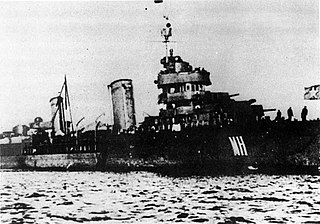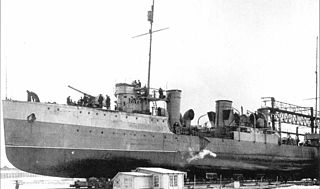
The Svetlana-class cruiser was the first class of light cruisers built for the Imperial Russian Navy (IRN) during the 1910s. Construction was interrupted by World War I, the Russian Revolution and the Russian Civil War. Only Svetlana of the quartet was completed by the Soviet Union as a cruiser, two were converted to oil tankers, and the remaining ship was scrapped without being completed.

Krasny Krym was a light cruiser of the Soviet Navy. She was laid down in 1913 as Svetlana for the Imperial Russian Navy, the lead ship of the Svetlana class. She was built by the Russo-Baltic Shipyard in Tallinn, Estonia, and launched in 1915. Her hull was evacuated to Petrograd when the Germans approached the port in late 1917 and laid up incomplete during the Russian Revolution. The ship was completed by the Soviets in 1926. During World War II she supported Soviet troops during the Siege of Odessa, Siege of Sevastopol, and the Kerch-Feodosiya Operation in the winter of 1941–42. Krasny Krym was awarded the Guards title on 18 June 1942. The ship was reclassified as a training ship in November 1954 before being scrapped in July 1959.

HNLMS De Zeven Provinciën was a De Zeven Provinciën-class cruiser of the Royal Netherlands Navy. Laid down in 1939, construction was interrupted by World War II and the ship was only commissioned in 1953 with the identification number C802. She served until 1976 when she was purchased by Peru and renamed Aguirre. With the Peruvian Navy she served until 1999 and was scrapped in 2000.

Novík was a destroyer of the Russian Imperial Navy and Soviet Navy, commissioned in 1913 where she served with the Baltic Fleet during World War I. She joined the Bolsheviks in November 1917 and was renamed Yakov Sverdlov in 1923. She was a training ship when Operation Barbarossa began, but was recalled to active duty the following day. She struck a mine on 28 August 1941 and sank while escorting an evacuation convoy during the Soviet evacuation of Tallinn.

The Derzky or Bespokoiny-class destroyers was a class of destroyers built for the Imperial Russian Navy just before World War I. Nine ships were built for the Black Sea Fleet. These ships were a derivative of the Novik, but were slightly smaller. These ships were popular with the Russians and effective particularly in the Black Sea, where the Ottoman Navy had no similar ships.

The Orfey-class destroyers were built for the Baltic Fleet of the Imperial Russian Navy. They were modified versions of the earlier destroyer Novik and the Derzky-class destroyers. These ships were larger, had triple torpedo tubes and an extra 102 mm (4 in) gun. One ship, Engels, was fitted with a 305 mm (12 in) recoilless rifle for testing in 1934. Fourteen ships were completed in 1914–1917 and fought in World War I and during the Allied intervention in the Russian Civil War. The survivors fought in World War II.
The Izyaslav class were a class of destroyers built for the Baltic Fleet of the Imperial Russian Navy. They were modified versions of the Orfey class built in Russia with the assistance of the French company Augustin Normand. These ships fought in World War I, the Russian Civil War, the Estonian War of Independence, and World War II.

Minsk was one of six Leningrad-class destroyer leaders built for the Soviet Navy during the 1930s, one of the three Project 38 variants. Completed in 1939, the ship was assigned to the Baltic Fleet and played a minor role in the Winter War against Finland in 1939–1940. After the start of Operation Barbarossa, the German invasion of the Soviet Union in June 1941, Minsk covered minelaying operations and provided naval gunfire support to Soviet units. She escorted ships during the Soviet evacuation of Tallinn, Estonia, in late August. The ship was sunk by German dive bombers on 23 September, although her wreck was salvaged in 1942 and repaired. Minsk was recommissioned in 1943 but the repairs were not completed until the following year. The ship was reclassified as a training ship in 1951, then became a target ship in 1958 and was sunk that year.

Zheleznyakov was one of eight Fidonisy-class destroyers built for the Imperial Russian Navy during World War I. She was originally named Korfu (Корфу) before she was renamed Petrovsky (Петровский) in 1925 and Zheleznyakov (Железняков) in 1939 after anarchist Anatoli Zhelezniakov.
At least four ships of the Peruvian Navy have been named BAP Almirante Guise or simply Guise:

Azard was one of eight Orfey-class destroyers built for the Russian Imperial Navy during World War I. Completed in 1916, she served with the Baltic Fleet and joined the Bolshevik Red Fleet after the October Revolution of 1918. She was active during the Russian Civil War, taking part in several engagements against British ships during the British campaign in the Baltic. The destroyer was renamed Zinoviev in 1922 and Artem in 1928. She remained in service with the Soviet Baltic Fleet when Germany invaded the Soviet Union in 1941, and was sunk by a mine on 28 August.
Izyaslav was the lead ship of her class of five destroyers built for the Russian Imperial Navy during the 1910s. Completed during 1916, she served with the Baltic Fleet during the remainder of the First World War, and after the October Revolution joined the Bolshevik Red Fleet. She was active during the Russian Civil War, taking part in several engagements against British ships during the British campaign in the Baltic. The destroyer was renamed Karl Marx in 1922. She played a small role in the Winter War with the Soviet Baltic Fleet when Germany invaded the Soviet Union in 1941, and was sunk by German aircraft on 8 August 1941.
Kalinin was one of five Izyaslav-class destroyers ordered for the Russian Imperial Navy during the 1910s. Not completed during the First World War, she was finally finished by the Soviets in 1927. She played a small role in the Winter War with the Baltic Fleet when Germany invaded the Soviet Union in 1941, and was sunk by naval mines on 28 August 1941.

Letun was one of eight Orfey-class destroyers built for the Russian Imperial Navy during World War I. Completed in 1916, she served with the Baltic Fleet during the war, but struck a naval mine in October that crippled her. The ship was under repair in Reval, Estonia, when the Soviets evacuated the city. Abandoned, Letun was broken up for scrap in 1927.

Samson was one of eight Orfey-class destroyers built for the Russian Imperial Navy during World War I. Completed in 1916, she served with the Baltic Fleet and joined the Bolshevik Red Fleet after the October Revolution of 1918. She was active during the Russian Civil War, taking part in several engagements against British ships during the British campaign in the Baltic. The destroyer was renamed Stalin in 1922. She was assigned to the Pacific Fleet when Germany invaded the Soviet Union in 1941 and saw little to no combat. The ship was scrapped in 1953.

Desna was one of eight Orfey-class destroyers built for the Russian Imperial Navy during World War I. Completed in 1916, she served with the Baltic Fleet and joined the Bolshevik Red Fleet after the October Revolution of 1918. She was active during the Russian Civil War, taking part in several engagements against British ships during the British campaign in the Baltic. The destroyer was renamed Engels in 1922. She remained in service with the Soviet Baltic Fleet when Germany invaded the Soviet Union in 1941, and was sunk on 24 August.

Pobeditel was one of eight Orfey-class destroyers built for the Russian Imperial Navy during World War I. Completed in 1915, she served with the Baltic Fleet and joined the Bolshevik Red Fleet after the October Revolution of 1918. She was active during the Russian Civil War, taking part in several engagements against British ships during the British campaign in the Baltic. The destroyer was renamed Volodarski in 1922. She remained in service with the Soviet Baltic Fleet when Germany invaded the Soviet Union in 1941, and was sunk on 28 August.

Zabiyaka was one of eight Orfey-class destroyers built for the Russian Imperial Navy during World War I. Completed in 1916, she served with the Baltic Fleet and joined the Bolshevik Red Fleet after the October Revolution of 1918. She was active during the Russian Civil War, taking part in several engagements against British ships during the British campaign in the Baltic. The destroyer was renamed Uritski in 1922. She was assigned to the Baltic Fleet when Germany invaded the Soviet Union in 1941, and survived the war to be scrapped in 1953.

Wambola was a destroyer of the Estonian Navy during the interwar period, originally a Russian Lejtienant Iljin-class ship. Previously, it was known as the Russian Kapitan I ranga Miklucha Maklai during World War I, later the Soviet Spartak, and subsequently the Peruvian Almirante Villar. The construction of the vessel began in 1914 for the Imperial Russian Navy, launched in 1915, and entered service in 1917 under the name Kapitan I ranga Miklucha Maklai. It avoided capture by the Germans by fleeing Helsingfors during the Ice March. The ship was taken over by the Bolshevik navy and renamed Spartak. During the conflict against Estonia, it participated in landing and mining operations. In December 1918, it was captured by the Royal Navy and handed over to the Estonians. In the Estonian Navy, it was named Wambola. During the Estonian War of Independence, it took part in operations against the Bolsheviks in the waters of the Gulf of Finland and in operations against the Baltische Landeswehr in Riga. After the war, it made occasional diplomatic visits. In 1933, due to high maintenance costs, it was sold to Peru. In the Peruvian Navy, it was named Almirante Villar. It did not manage to participate in the Colombia–Peru War but took part in battles against Ecuador in 1941. During World War II, it served in patrol duties and was decommissioned in 1954.









